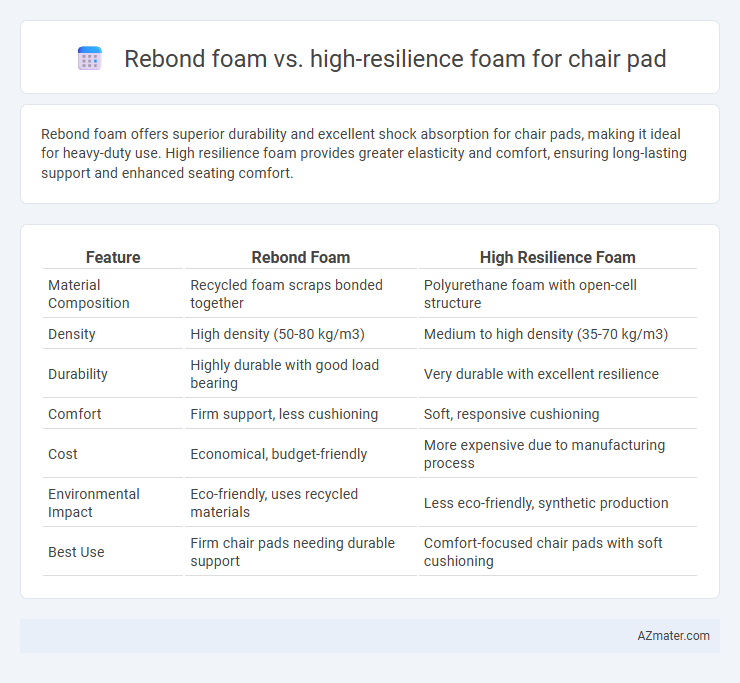Rebond foam offers superior durability and excellent shock absorption for chair pads, making it ideal for heavy-duty use. High resilience foam provides greater elasticity and comfort, ensuring long-lasting support and enhanced seating comfort.
Table of Comparison
| Feature | Rebond Foam | High Resilience Foam |
|---|---|---|
| Material Composition | Recycled foam scraps bonded together | Polyurethane foam with open-cell structure |
| Density | High density (50-80 kg/m3) | Medium to high density (35-70 kg/m3) |
| Durability | Highly durable with good load bearing | Very durable with excellent resilience |
| Comfort | Firm support, less cushioning | Soft, responsive cushioning |
| Cost | Economical, budget-friendly | More expensive due to manufacturing process |
| Environmental Impact | Eco-friendly, uses recycled materials | Less eco-friendly, synthetic production |
| Best Use | Firm chair pads needing durable support | Comfort-focused chair pads with soft cushioning |
Introduction to Chair Pad Foam Types
Rebond foam offers exceptional durability and density by recycling shredded foam bonded together, providing firm support ideal for heavy-use chair pads. High resilience foam delivers superior elasticity and comfort with its open-cell structure, ensuring better cushioning and prolonged shape retention. Both materials are popular in chair pad manufacturing, balancing support and comfort based on user preferences and seating demands.
What is Rebond Foam?
Rebond foam is a type of cushioning material made by bonding together shredded pieces of foam with adhesive to create a dense, durable pad suited for high-impact areas. It offers superior support and resilience compared to traditional foam, making it ideal for chair pads that require long-lasting comfort and pressure distribution. The recycled nature of rebond foam also provides an eco-friendly advantage while maintaining excellent structural integrity.
What is High Resilience Foam?
High resilience foam is a type of polyurethane foam known for its superior support, durability, and elasticity, making it ideal for chair pads that require long-lasting comfort and shape retention. Unlike rebond foam, which is made from shredded foam pieces bonded together and often used for heavier-duty applications, high resilience foam offers a more consistent, smooth surface and faster recovery time after compression. This foam is engineered to provide enhanced cushioning, improved weight distribution, and resistance to sagging, which enhances the ergonomic benefits for chairs.
Durability Comparison: Rebond vs High Resilience
Rebond foam offers exceptional durability due to its dense composition made from shredded foam scraps bonded together, providing strong resistance to compression and wear over extended use. High resilience foam, characterized by its highly elastic open-cell structure, delivers superior comfort with faster recovery but tends to break down faster under heavy, continuous pressure compared to rebond foam. For chair pads requiring long-term durability, rebond foam generally outperforms high resilience foam by maintaining structural integrity and support over time.
Comfort Levels and Support
High resilience foam offers superior support and durability due to its ability to quickly regain shape and distribute weight evenly, making it ideal for prolonged seating. Rebond foam, made from shredded foam pieces bonded together, provides firmer support and resilience but may feel denser and less cushioning over time. Chair pads with high resilience foam typically deliver enhanced comfort with better shock absorption, while rebond foam excels in providing a sturdy base where firmness is prioritized.
Density and Firmness Differences
Rebond foam typically has a higher density, ranging from 50 to 80 kg/m3, which provides a firmer and more supportive chair pad compared to high resilience foam that usually has a density between 30 to 50 kg/m3. The firmness of rebond foam is greater due to its composition from bonded foam scraps, offering enhanced durability and impact resistance ideal for heavy use. High resilience foam, characterized by its elasticity and quicker recovery time, tends to be softer and more cushioned, emphasizing comfort over the rigidity found in rebond foam.
Cost Comparison
Rebond foam is generally more cost-effective than high resilience foam due to its manufacturing process that recycles scrap foam, making it a budget-friendly option for chair pads. High resilience foam, while more expensive, offers superior durability and support, justifying its higher price in long-term use. For cost-conscious buyers, rebond foam provides an economical choice without compromising basic comfort, whereas high resilience foam represents an investment in quality and longevity.
Best Applications for Rebond Foam
Rebond foam is ideal for chair pads requiring exceptional durability and firm support, commonly used in heavy-use environments like office chairs and commercial seating. Its high-density composition provides excellent impact absorption and shape retention, making it suitable for prolonged sitting periods. Compared to high resilience foam, rebond foam excels in applications demanding long-term resilience and structural integrity under constant pressure.
Best Applications for High Resilience Foam
High resilience foam offers exceptional durability and support, making it ideal for chair pads in office and gaming environments where prolonged sitting occurs. Its open-cell structure provides superior breathability and resilience, enhancing comfort and maintaining shape over time. Compared to rebond foam, high resilience foam better absorbs impact and reduces pressure points, promoting ergonomic seating and reducing fatigue.
Which Foam is Better for Chair Pads?
High resilience (HR) foam offers superior durability and better support for chair pads compared to rebond foam, making it ideal for prolonged use and maintaining comfort over time. Rebond foam, made from recycled foam scraps bonded together, provides good firmness and cost-effectiveness but typically lacks the consistent elasticity and cushioning quality of HR foam. For chair pads requiring long-term resilience, pressure distribution, and enhanced comfort, high resilience foam is the better choice due to its ability to retain shape and provide balanced support.

Infographic: Rebond foam vs High resilience foam for Chair pad
 azmater.com
azmater.com